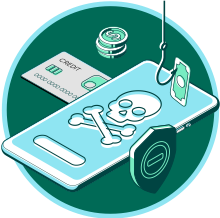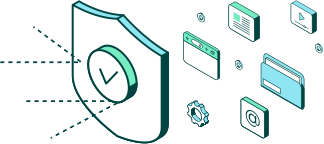What Is Advanced Threat Protection?
As cybersecurity advances, so do cyberattacks, which is why sophisticated malware has become more of a threat and better at evading detection. To stay protected, organizations need to add new layers of security. Advanced Threat Protection (ATP) is a security solution that identifies and protects against intelligent malware or hacking attacks aimed at gaining access to an organization’s data.
The understanding of enterprise data, its sensitivity, and value are critical in managing an appropriate response to advanced threats causing an organization harm. An organization needs to be aware of its data before it can begin to protect itself from advanced threats.
Common Cybersecurity Threats
Phishing
Phishing is fraudulent email designed to trick someone into revealing sensitive information to the attacker or to deploy malicious software, like ransomware, on the victim's infrastructure.
Social Engineering
Social Engineering is a manipulation of people/employees to gain confidential information within the organization.
Man in the Middle (MITM)
Man in the Middle (MITM) is when cybercriminals insert themselves into a conversation between a user and an application.
Zero-Hour Threats
Zero-Hour Threats are threats not previously detected and therefore next to impossible to detect with traditional signature solutions.
Malware vs. Ransomware
While malware and ransomware are sometimes used interchangeably when discussing cyber threats, it is an oversight. Though, it is true that they are related; all ransomware is malware, but all malware is not ransomware.
Malware is malicious software used to gain unauthorized access to information or systems. In doing so, malware can leak information and even deny legitimate users access to their information.
- Point of Entry: Emails, hyperlinks, application installations, websites, etc.
- Effects: While it may not destroy an organization, it can severely impact performance and day-to-day operations.
- Can it be resolved: Yes, with proper software, malware can be blocked or removed.
Ransomware is a type of malware used to hold data hostage from the data owners until a demand is paid.
- Point of Entry: Typically, through phishing emails
- Effects: Ransomware is often so crippling that business operations shutdown.
- Can it be resolved: Yes, but it will be costly. While tremendously complex, it can be restored based on backups or paying the ransom fee demanded.
An Example of Ransomware
Ransomware is the winner when it comes to media attention. In 2021, a ransomware attack made global news with the five-day shutdown of a major artery for fuel along the US East Coast. Worried their systems could be further compromised, the organization ceased distribution causing a panic among motorists. Their decision to shut down operations perpetrated many outcomes including limited operations of mass transit and refineries with ample product and no way to distribute. After paying millions in crypto currency to get their data back, they had to begin the process of decrypting their data.
The attack globally exposed the ease at which cybercriminals were able to cause so much chaos in institutions that many did not see as easily infiltrated. The financial and reputable damage far outweighs the preventable costs. Learn more about some of the most pervasive ransomware attacks today.
Types of Phishing Attacks
There are different types of phishing attacks, some are more sophisticated than others. Here are a few examples of the most common types:
An Example of Phishing Attacks

An example of a famous spear phishing event was in 2014. Scammers, pretending to be the CEO of a North American drug company, emailed an accounts payable coordinator instructing the employee to make nine wire transfers totaling more than $50 million. The email, which aside from the CEO also labeled lawyers approving the transfers, reassure the employee.
Once the company noticed the abnormally quick transfers of large sums of money, they were able to retract some of the transfers. But in the end, the event cost them $39 million. While spear phishing may seem simple, it continues to be a successful way to scam organizations and should not be taken for granted.
How Advanced Threat Protection Solutions Work
There are three significant actions an ATP solution must achieve for it to be impactful:
1) It must stop an identified attack or alleviate threats before they compromise the organization’s systems.
2) If an attack has made its way in, the ATP should disrupt activity in process or counter the damage already made by the attack.
3) The ATP solution needs to interrupt the growth of the attack to make sure the threat cannot advance.
Why Clearswift Is Best Against Advanced Threats
To protect your organization from advanced threats, your security solutions require a deeper level of inspection and remediation. While other security solutions scratch the surface of a document, in-real time Clearswift deconstructs files and messages down to their lowest parts for inspection. If malicious content or cyber threats are uncovered, it automatically removes, deletes, or sanitizes the files or messages. Once remediation has taken place, the files are reconstructed back to their original form to continue without delay. Get a closer look at how Clearswift protects against attacks with Advanced Threat Protection.
Sanitization
Sanitization removes malicious content such as macros or active code, as well as document properties including comments or track changes to prevent attacks from gaining access to systems or information for social engineering.
Signature-Less Detection
Unlike the popular signature-based detection, which uses previous attacks to identify threats, Clearswift protects against today’s leading malware and tomorrow’s even more sophisticated variants by noticing bad conduct. The Signature-less detection uses knowledge from previous attacks and attack attempts to make educated decisions on attacks not yet introduced to security solutions based on how they are behaving. This quicker detection is crucial with new malware increasing daily.
Sandboxing
Supplement antivirus solutions with the cloud-based Sandbox. It further inspects messages considered suspicious by the antivirus solution and sends the results back where the file is either blocked, dropped, or subjected to further analysis.
Related Resources
Easy Add-On. No Rip and Replace.
See how Clearswift vendor neutral add-on to your existing security infrastructure or Clearswift Secure Gateways to sanitize email, web, social media, managed file transfer (MFT), web applications, cloud collaboration tools, and more can help you fight advanced threats.

